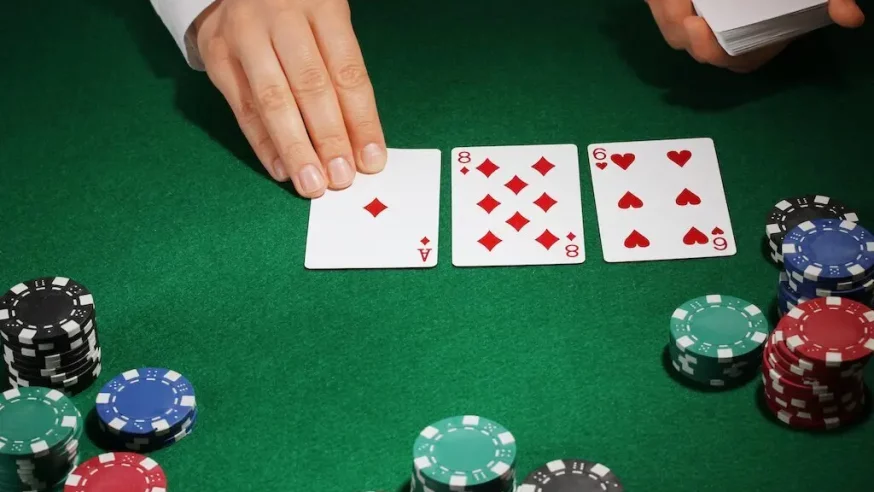
You’re at the poker table, adrenaline pumping through your veins, and your eyes fixed on the dealer as they reveal the first three community cards—the flop. You know that this is a hot moment, as it can turn your mediocre hand into a winning one or dash your hopes of a big win.
If you can’t think of something in this life-and-death stage of the game, you may end up leaving the table empty-handed.
So, how do you recognize the different types of flops and make the best decisions for your hand? Well, you’re about to find out!
Let’s explore some common flop types you might encounter and how to handle them to improve your odds of winning.
Before we jump into things, let’s take a moment to zoom out and give you a quick refresher on what we mean by a flop.
In poker, the “flop” is when those first three community cards are laid out face-up on the table. This happens after the first round of betting where everyone’s been dealt their hole cards.
These cards are shared by all players–they can use them with their two private cards to form the best possible five-card hand.
The flop doesn’t just show you how strong your hand is—it also lays the groundwork for the next rounds of betting and strategy.
Experienced poker players can identify and assess when flops are “good” or “bad.” To do this, they consider:
With that being said, the common types of flops include:
Let’s discuss each one after the other.
A wet flop creates many drawing possibilities for straight or flush draws (and even made straights!)
They usually include cards that are close in rank and/or share the same suit. Since they’re filled with cards that connect well together, they can also be called “coordinated” flops.
Flops like 10♦ 9♠ 8♠ and K♣ Q♣ 10♦ are considered wet because they provide opportunities for straight and flush draws.
(Pro tip: If you have a strong made hand on a wet flop–such as a set or two pair–it’s advisable to bet aggressively.)
You may have already guessed that this is the total opposite of a wet flop.
Also referred to as “uncoordinated”, a dry flop isn’t likely to help players complete a draw. They only provide what’s called “backdoor” draws, which need both the turn and river cards to come through in order to complete.
It typically consists of cards of different suits and ranks; this makes it less likely for straights and flushes to occur.
For example, a flop of 2♦ 7♣ K♠ is considered dry.
(Pro tip: If you raised preflop, a dry flop provides an excellent opportunity to make a c-bet because the chances are high that your opponents haven't connected with the board!)
A high flop contains two or three “Broadway” cards (cards ranked 10 or higher.) They include Tens, Jacks, Queens, Kings, and Aces.
High flops are more likely to connect with the pre-flop raising ranges of many players. They can also lead to strong hands and tons of drawing opportunities.
Q♠ K♣ A♦ is considered a high flop.
A low flop has two or three cards that rank 8 or lower. Examples of low flops include 3♠ 5♦ 7♣ or 2♥ 4♣ 6♠.
These flops are typically considered “dry” since they don’t support many straight or flush draws.
A dynamic flop (or “action” flop) is one where the winning hand likely is not made yet, and the turn and the river can change the winner of the hand. They occur when there are flush draws, straight draws, or low cards.
Examples include flops like 10♠ 9♣ 6♠ or 7♣ 5♠ 2, where several potential hands can continue to improve with the turn and river cards.
A dynamic flop keeps the game interesting and engaging as it doesn’t give any player a clear advantage.
With a static flop, it is very very likely that the winning hand is already locked in. It favours one player and makes it less likely for others to continue.
Tl;dr? If you have the best hand on a static flop, it’s likely to remain that way by the end of the hand. Static flops often contain monotone, paired, or high cards. (We’ll dive into the first two terms in the next section.)
Examples include A♠ 9♠ 5♥ or K♠ J♦ 2♥.
Simply put, a flop’s texture refers to how its cards interact with typical hand ranges.
It’s the starting point of the post-flop strategy after hand ranges have been clearly defined by the pre-flop action.
Flop textures are commonly defined using these key properties: Suitedness, Connectedness, and Paired.
Let’s discuss these in more detail:
This refers to the presence of cards of the same suit on the flop and whether flush draws or made flushes are possible. The flops can be:
This refers to how many connected or closely joined cards are on the board, indicating whether straight draws or made straights are possible.
For example, a flop like 5♥ 7♦6♠ is considered highly connected.
The two many types of connected flops include:
A paired flop occurs when two of the three community cards are of the same rank.
An example of a paired flop is 5♣ 5♦ 10♠. This setup can lead to various strong hands, including trips–three of a kind–or a full house.
(Note: A paired flop can appear roughly 17% of the time.)
Also, they can range from low pairs like 2♠ 2♦ 7♣ to high pairs such as K♠ K♣ 3♦.